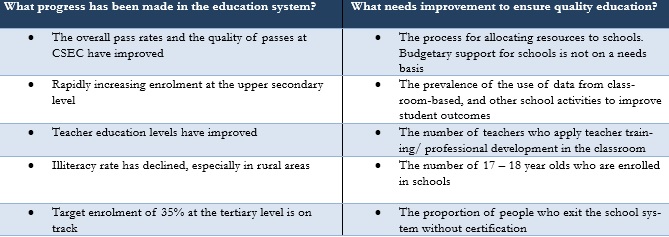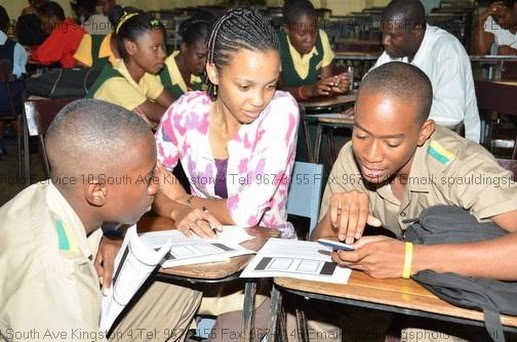EduFocus #17 JAMAICA’S PROGRESS TOWARDS EQUITY AND QUALITY
JAMAICA’S PROGRESS TOWARDS EQUITY AND QUALITY: HOW ARE WE DOING IN THE EDUCATION SECTOR?
Jamaica has been steadfastly tackling the issues that impede progress towards offering quality education for each child. Having recognised the significant role education plays in national development, it is critical to monitor how well Jamaica is doing in achieving the standards and outcomes that are synonymous with a good education system.
In the late 1990s, the Partnership for Educational Revitalization in the Americas (PREAL) convened two international Task Forces to discuss the deficiencies in the education systems within Latin America and the Caribbean. They proposed the following steps for school improvement:
 The Caribbean Policy and Research Institute (CAPRI) in collaboration with PREAL published Jamaica’s education report card in 2013. The publication of this report card allows stakeholders to take a comprehensive look at key aspects of education—access, quality and equity—that are essential for improving learning outcomes. In addition, it provides insight about “how schools are organised, how much they cost, what they produce and who is responsible for these outcomes” (CAPRI and PREAL, 2013)
The Caribbean Policy and Research Institute (CAPRI) in collaboration with PREAL published Jamaica’s education report card in 2013. The publication of this report card allows stakeholders to take a comprehensive look at key aspects of education—access, quality and equity—that are essential for improving learning outcomes. In addition, it provides insight about “how schools are organised, how much they cost, what they produce and who is responsible for these outcomes” (CAPRI and PREAL, 2013)

FACTORS AFFECTING STUDENT OUTCOMES
Similar to discussions occurring in many quarters, the report noted persistent low scores in national examinations at all levels of the education system.
 From the report, it can be inferred that the Jamaican education system suffers from three major weaknesses: inadequate leadership, inadequate resources and a low accountability environment. The factors related to each weakness is highlighted below.
From the report, it can be inferred that the Jamaican education system suffers from three major weaknesses: inadequate leadership, inadequate resources and a low accountability environment. The factors related to each weakness is highlighted below.
Inadequate Leadership
• Lack of leadership and management skills among school principals
• The strong practice of promoting Senior Teachers and Acting Principals to the role of principal without training
• There is lack of financial expertise and supervisory capacity.
Inadequate Resources
• Schools are inadequately resourced
• Lack of consideration for schools’ ability to access supplementary funds when the allocated resources are inadequate
• The student pupil ratio established by the Ministry of Education is constrained by staffing options.
• Migration of teachers skilled in specialized areas such as Special education
Low Accountability Environment
• Lack of structured effective ways through which the community can participate in the management of their schools and monitoring their performance.
• The reluctance to recommend students for national examinations who are perceived as likely to fail
• Schools tend not to use data from examinations for school improvement or inform/ improve instruction
• School non-attendance
• Lack of systematic follow up to ensure that that skills acquired from training is applied to the classroom.
The heavy investments in education (6.1% of GDP in 2010) can be observed in many quality initiatives such as the school improvement projects (Basic Education project, Expanding Educational Horizon Project), National Education Inspectorate, which is the quality control and assurance mechanism and the National College for Educational Leadership that will promote development through the training of principals and vice principals. The promise of these initiatives is great, as it offers an opportunity to build a culture of accountability without blame and drive holistic system improvement. Thus, despite the fact that Jamaica’s hope for equity and quality within the education system is not yet realized, it is in reach.
Click here to read the report.
Recommendations
1. Continue to phase out all age and junior high schools as data indicates students are less likely to enroll after grade 9
2. Implement initiatives to promote school enrolment among older students such as internship and apprenticeship opportuni-ties
3. Ensure that students sit the required num-ber of CSEC subjects
4. Change the target attendance of 161 days as students miss 6 weeks of valuable con-tact time on average.
5. Participate in at least one global test of student achievement
6. Improve students opportunities to learn through the use of gender based teaching, improved school plans and distributing a minimum ‘basket’ of instructional and learn-ing resources
7. Develop mechanisms, apart from annual tests, to identify and address learning chal-lenges early
8. Ensure teachers are equipped to handle challenges by offering focused profession-al development to teachers and entrench-ing a mentorship period in the teaching profession.
9. Train all school administrators in strategic and operations management
10. Give schools more autonomy in school’s daily operations in exchange for greater responsibility for results
11. Establish annual performance targets at the secondary level
12. The secondary curriculum should be mapped and sequenced to the CSEC syl-labi from Grade 7
13. Implement differentiated instructional methods in the classroom to cater to stu-dents of different learning styles
14. The budgeting process needs to reflect the needs of the school rather than the alloca-tion solely by education level.
CAPRI & PREAL, 2013, P. 39

 Visit our Help Center to find answers to frequently asked questions.
Visit our Help Center to find answers to frequently asked questions.